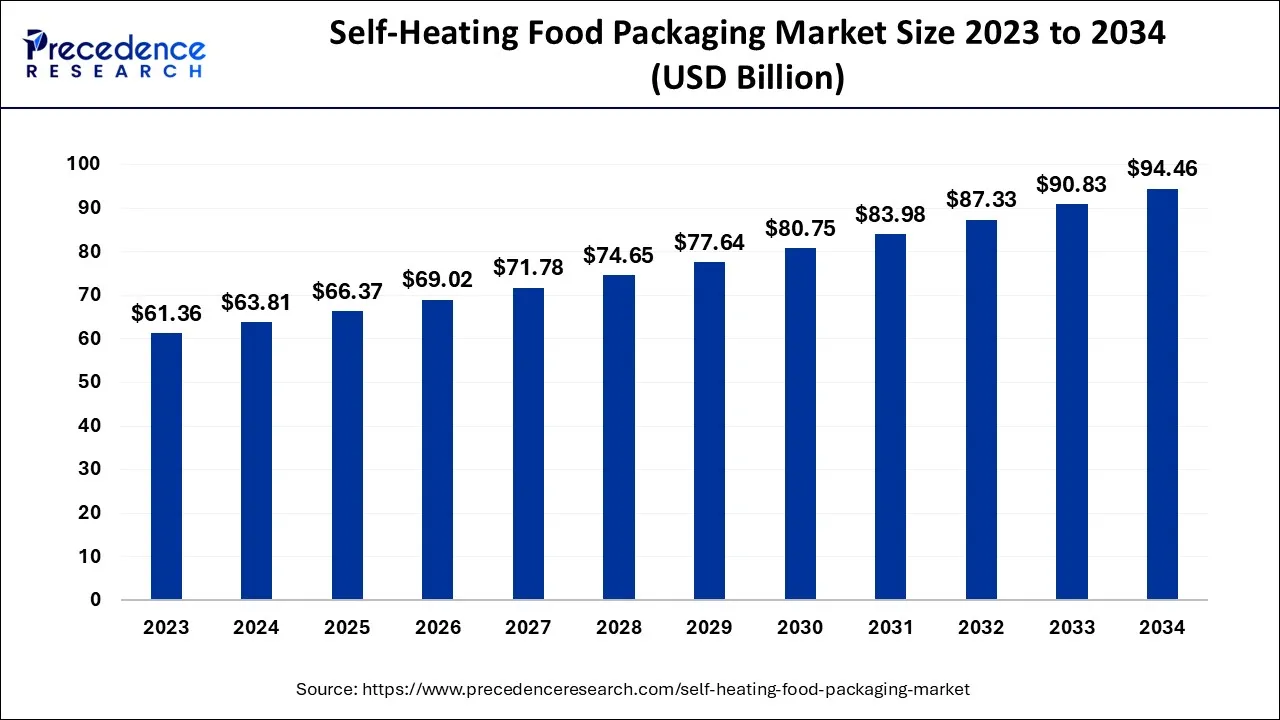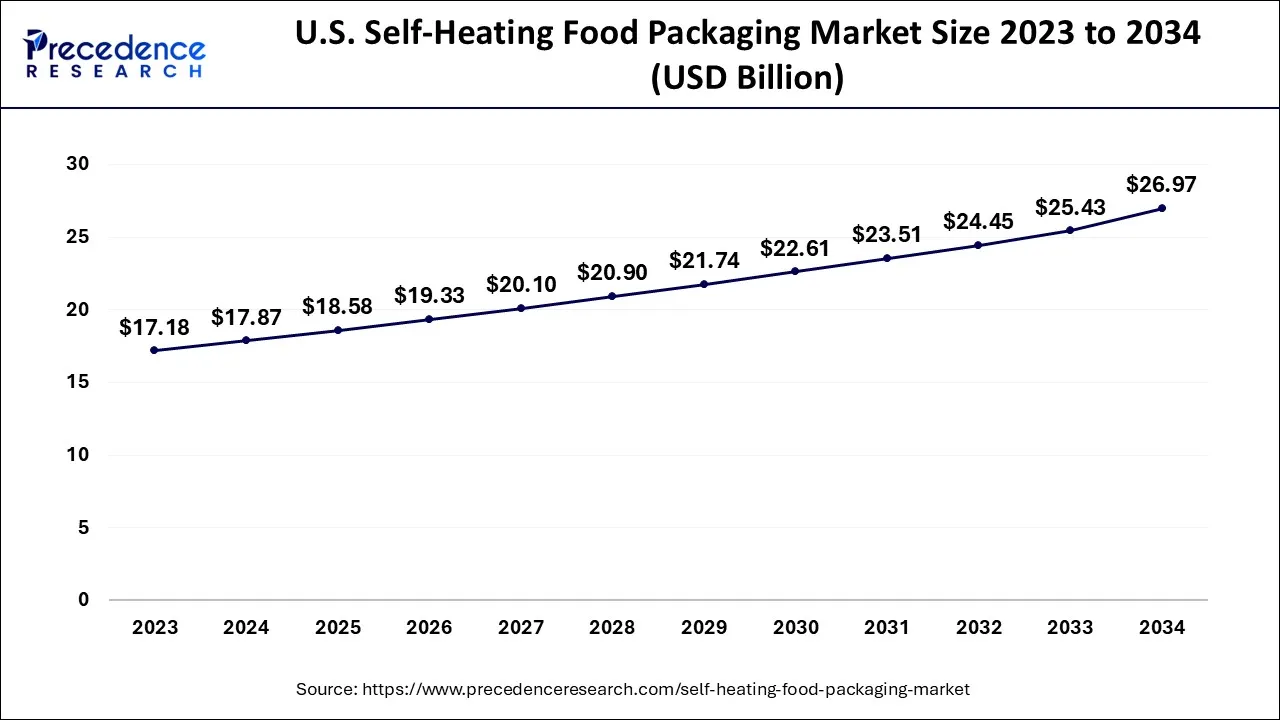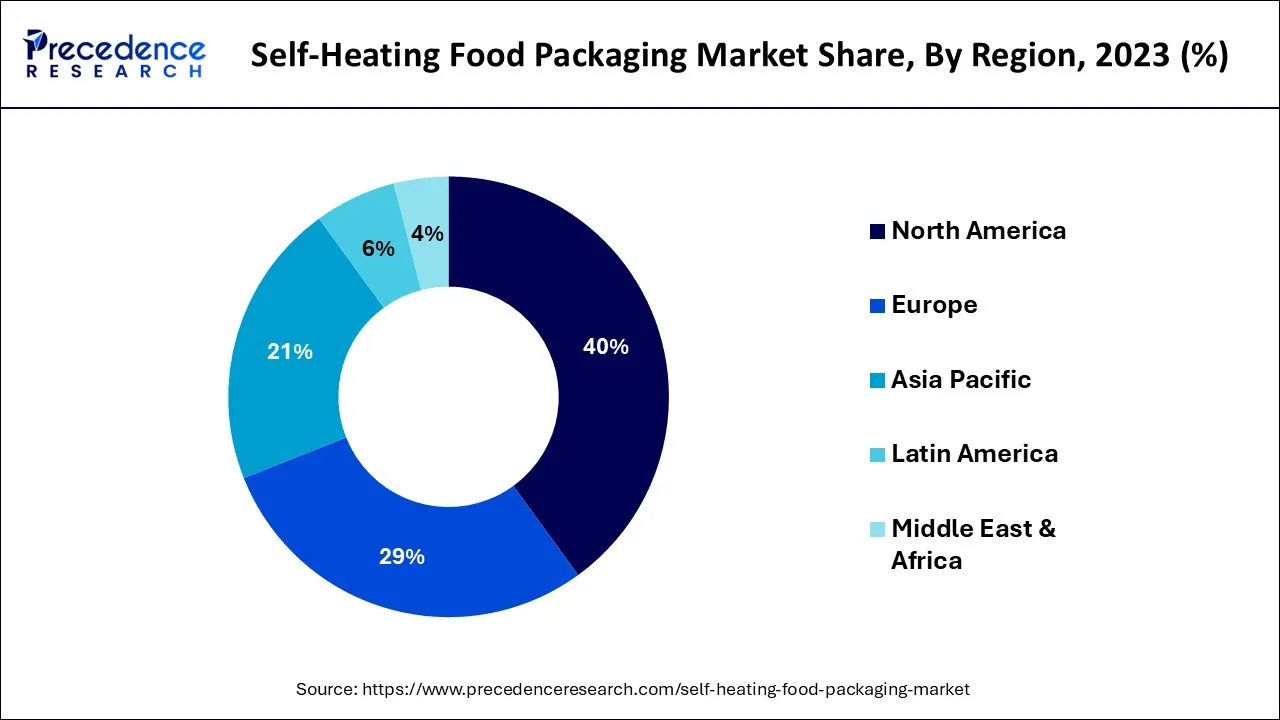List of Contents
What is the Self-Heating Food Packaging Market?
The global self-heating food packaging market size is calculated at USD 66.37 billion in 2025 and is predicted to increase from USD 69.02 billion in 2026 to approximately USD 94.46 billion by 2034, expanding at a CAGR of 4% over the forecast period from 2025 to 2034.

Self-Heating Food Packaging Market Key Takeaways
- North America led the global market with the highest market share of 40% in 2024.
- By packaging type, the containers segment residential the biggest market share in 2024.
- By end-use, the beverages segment has held the highest market share in 2024.
Market Overview
Consumer tastes, trends, and specialized interests have all been significant factors in the growth of the food and beverage industry. Due to rising customer demand for ready-to-eat, convenient, moderately processed food items with extended shelf lives and excellent quality standards, packaging trends in the food and beverage industry have also seen significant modification in recent years. Modern food packaging has undergone considerable modifications as a result of lifestyle changes, with self-heating food packaging becoming increasingly popular.
The packaging industry is rapidly eschewing old packaging methods in favour of more cutting-edge ones that have just lately been created such as, active packaging, intelligent packaging and bioactive packaging. Food packaging with the capacity to heat food components without the use of an external heat source is said to have self-heating capabilities. The exothermic process serves as the heat source for the self-heating food packaging.
The self-heating food packaging consists of two chambers: one for the heating unit and the other for food and drink storage. By pushing the button outside the packing, the heating unit is turned on. Quicklime and water are used in an exothermic chemical process to produce heat. Self-heating food packaging is typically used by military personnel, construction workers, and mountaineers in places where traditional cooking is not possible, but it is now becoming a regular practise among customers who are sluggish.
Additionally, self-heating food packaging is growing in favour among parents who must transport their children. In spite of the fact that the market for self-heating food packaging is still in its infancy, rising consumer awareness of its functionality and advantages is anticipated to lead to considerable demand over the course of the forecast period. Parents who must travel over long distances while carrying their infants are becoming more and more interested in self-heating food packing. The primary element accelerating the self-heating food packaging market expansion is the rise in demand for convenient food items and the level of life among consumers throughout the world.
The market for self-heating food packaging is being driven by a number of factors, including an expanding global food and beverage industry, a rise in the demand for wholesome on-the-go food items, an increase in the demand for ready-to-eat foods and confectionary foods and beverages like soups, tea, and coffee, rising food and beverage consumption, and changing consumer lifestyles. Furthermore, the market for self-heating food packaging will see new growth prospects as a result of increased technical breakthroughs, modernization of packaging processes, and growth in demand from emerging nations. In the future years, the market for self-heating food packaging is expected to develop under the effect of changing customer preferences.
Although there are other factors limiting market growth, the rise in the usage of chemical heat sources and government strict environmental pollution regulations are the main ones. These factors will make the economy for self-heating food packaging even more difficult to expand.
AI in the Market
AI is revolutionizing the self-heating food packaging industry by increasing its innovation, efficiency, and safety. Waste reduction, faster response, and more streamlined logistics are achieved by means of prediction analytics based on AI for demand forecasting and inventory optimization. Smart automation delivers very fast production, while computer vision recognizes defects with high precision. AI helps in sustaining the environment by optimizing material use and increasing shelf life. Consumers benefit, too, as safer heating mechanisms are designed to reduce usage risk. Personalization of product innovation is achieved through AI by analyzing nutritional trends and consumer behavior, rewriting the market of self-heating food packaging.
Self-Heating Food Packaging Market Growth Factors
In many situations, including those involving the military, mountaineers, field engineers, and others when traditional cooking is not possible, self-heating food packaging is employed. The flameless ration self-heating container, which contains an integrated water triggered exothermic heater, is used by military troops to cook meals such as meats and other items. Within 12 minutes, the flameless ration self-heating container rises the temperature of its contents and immediately heats the meal. The magnesium metal and water undergo an exothermic reaction, which generates the heat used in this food packing. In addition, one of the widely used technologies for self-heating food packaging is heatgenie technology. The heatgenie is a typical heat source in food packaging that occupies 1 oz of the entire container capacity and is relatively adaptable. The aluminium and silica ingredient combine to generate heat, which is then transferred to the food within. Additionally, instantaneous heating of cold coffee into hot coffees is accomplished using the self-heating technology.
- The self-heating food packaging business is expanding as a result of changes in customer preferences for lengthy trips, discretionary cash, and changing lifestyles.
- During the projected period, rising demand for quick meals such noodles and reviving beverages like soups and tea is anticipated to propel market expansion.
- Increasing R&D efforts to create new self-heating technologies are opening up several opportunities for industry expansion.
- During the forecast period, rising consumer awareness of the benefits and practicality of self-heating food packaging products is anticipated to drive market growth.
- Growing demands for convenient ready-to-eat food solutions are driving the demand for self-heating packaging from various consumer classes.
- Hiking, camping, or traveling lifestyles and recreation act as an incentive to use portable heat-on the-go solution.
- Expanded use in beverages, soups, and instant meals facilitates a wider adoption of the product in the market.
- Dedicated R&D into heat-generating technologies to improve the functional capabilities and safety of a product is opening up avenues.
- The shift towards newer types of packaging that focus on convenience and functionality is further accelerating the growth of the market.
Market Scope
| Report Coverage | Details |
| Market Size in 2025 | USD 66.37 Billion |
| Market Size in 2026 | USD 69.02 Billion |
| Market Size by 2034 | USD 94.46 Billion |
| Growth Rate from 2025 to 2034 | CAGR of 4% |
| Largest Market | North America |
| Base Year | 2024 |
| Forecast Period | 2025 to 2034 |
| Segments Covered | Packaging Type, End Users, Application, Distribution Channel, and Regions |
| Regions Covered | North America, Europe, Asia-Pacific, Latin America and Middle East & Africa |
Market Dynamics
Market Drivers
- Changing Consumer Lifestyles and Tastes - Consumer tastes, trends, and specialized interests have all been significant factors in the growth of the food and beverage industry. Due to rising customer demand for ready-to-eat, convenient, moderately processed food items with extended shelf lives and excellent quality standards, packaging trends in the food and beverage industry have also seen significant modification in recent years. Modern food packaging has undergone considerable modifications as a result of lifestyle changes, with self-heating food packaging becoming increasingly popular. The packaging industry is rapidly eschewing old packaging methods in favour of more cutting-edge ones that have just lately been created, such as intelligent packaging, active packaging, and bioactive packaging.
- Self-heating food packaging demand is increased by reticent consumers. Fast-paced consumer lives have created new opportunities for the food and beverage and food packaging industries, particularly in metropolitan regions throughout the world. Interest in self-heating food packaging solutions has increased over the past few years, despite stakeholders' increased efforts to find novel packaging solutions. In order to prevent outside heat from interfering with the food contained within the food container, heat insulator layers are being employed more often in the self-heating food packaging industry.
Market Challenges
- Weak distribution networks: The low availability of self-heating food packaging solutions is a result of these goods' weak distribution networks. Due to this, sales of self-heating food packaging solutions have been stagnant for the previous few years.
- Increase in the use of chemicals as heat sources - The use of different chemicals as heat sources is on the rise. Exothermic reaction chemicals make recycling cans challenging and harm the environment. Because of the high cost of these food cans due to the chemicals utilized, the market growth during the projection period would be constrained.
- Low Consumer Awareness: Even in developed areas like Europe and North America, conventional packaging forms are predominated, and consumer awareness of the advantages of on-the-go food with self-heating packaging is comparatively quite low.
Market Opportunities
- Personalization - The market for self-heating food packaging has seen tremendous growth in the major trend of personalization. Some of the key reasons that are projected to propel the worldwide self-heating food packaging market during the forecast period include the expanding trend of personalization, innovative, patented self-heating food packaging innovations, and the move toward holistic products.
- Numerous Benefits of Using Self-heating Food Packaging- A very practical packaging option for food and beverages is self-heating food packaging. In self-heating packaging, consumers may rapidly and easily heat food and beverage goods wherever they are. Utilizing goods in self-heating packaging allows fast-moving commuters to consume meals and beverages while on the go while saving time and energy. These benefits that self-heating food packaging offers over traditional packaging options are anticipated to boost acceptance of the former and foster market expansion for this type of packaging.
Segment Insights
Packaging Type Insights
The self-heating packaging market is anticipated to be dominated by the containers sector, which produced significant revenue in the year 2024. The self-heating container's increased appeal among travellers and how user-friendly it is might be contributed to the category growth. On the other hand, the cans category is anticipated to command a sizeable market share in the years to come due to its efficient heat up and portability. Additionally, producers are launching intelligent packaging tools including sensors, time-temperature indications, self-heating containers, and self-cooling containers. Incorporating electronic displays into this smart package. During the anticipated period, this aspect is anticipated to fuel market expansion for self-heating food packaging.
End Use Insights
As end-users choose cans and bottles for the packaging of liquid items including soups, tea, and coffee, the beverages segment will experience profitable expansion throughout the projection period. The market for self-heating food packaging is expanding due in large part to customer demand for ready-to-eat foods, the rise of consumers who are always on the go, and rising consumer expenditure on packaged foods and beverages. Due to rising customer demand for ready-to-eat, convenient, moderately processed food items with extended shelf lives and excellent quality standards, packaging trends in the food and beverage industry have also seen significant modification in recent years. Moreover, the beverage industry has seen a greater increase in demand for self-heating food packaging. While revenues from drinks are anticipated to be higher for market participants in the self-heating food packaging industry, revenues from food are anticipated to grow significantly throughout the forecast period.
Regional Insights
U.S. Self-Heating Food Packaging Market Size and Growth 2025 to 2034
The U.S. self-heating food packaging market size is accounted at USD 18.58 billion in 2025 and is projected to be worth around USD 26.97 billion by 2034, poised to grow at a CAGR of 4.2% from 2025 to 2034.

What Made North America the Dominant Region in the Self-Heating Food Packaging Market?
North America dominated the self-heating food packaging market with the largest share in 2024. This is mainly due to its strong demand for convenient, ready-to-eat meals driven by busy lifestyles, outdoor recreation, and military applications. The region benefits from advanced packaging technologies, well-established food processing industries, and continuous innovation from key manufacturers. Additionally, high consumer acceptance of on-the-go meal solutions and robust distribution networks further strengthen North America's leadership in this market.
U.S. Self-Heating Food Packaging Market Analysis
In the U.S., the market is growing due to the rising consumer demand for ready-to-eat meals driven by a busy lifestyle. Leading companies such as HeatGen and Tempra Technology are advancing commercial growth through innovative product development and strategic partnerships. Increasing emphasis on sustainability and rising demand from the military sector are further accelerating the adoption of self-heating food packaging.

How is Asia Pacific Contributing to the Self-Heating Food Packaging Market?
Asia Pacific is expected to grow at a significant CAGR over the forecast period, driven by increasing focus on sustainability and food safety. The region is implementing regulations for single-use packaging and plastic waste. This, in turn, boosts the demand for sustainable yet durable self-heating packaging solutions. The food contact material regulations aim to ensure compliance and safety with international standards. The growing preference for ready-to-eat meals, driven by busy lifestyles and rapid urbanization, is also driving the market in Asia Pacific.
India Self-Heating Food Packaging Market Analysis
India is considered a major player in the market within Asia Pacific. The country's market is driven by the expanding food & beverages sector and by several regulations on food safety and quality. In April 2025, Shri Prataprao Ganpatrao Jadhav, the Union Minister of State for Health and Family Welfare, hosted a National Stakeholder Consultation on ‘Sustainable Packaging for Food Business,' organized by the Food Safety and Standards Authority of India (FSSAI) in Mumbai. The FSSAI of India updated food packaging regulations to promote sustainability in the food industry.
What are the Major Trends in Europe Influencing the Market?
The market in Europe is influenced by several factors. The European Commission has introduced new rules aimed at fostering a sustainable and competitive packaging economy. These measures promote circular material use, improve resource efficiency, strengthen competitiveness, and enhance economic security. European companies are responding by investing in innovative products such as self-heating coffee cans and meal kits for travelers and military personnel, while EU sustainability regulations push for fully recyclable packaging by 2030 and greater adoption of reusable and refillable solutions.
France Self-Heating Food Packaging Market Analysis
In France, self-heating food packaging is gaining traction thanks to growing consumer demand for convenience, especially among busy urban consumers, travelers, and commuters who appreciate ready-to-eat meals requiring minimal preparation. Sustainability is also boosting the market. Increasing environmental awareness and regulatory pressure on packaging are prompting manufacturers to develop eco-friendlier self-heating solutions that use recyclable or biodegradable materials.
How is the Opportunistic Rise of Latin America in the Self-Heating Food Packaging Market?
Latin America is expected to experience an opportunistic rise in the market during the forecast period. The regional market is driven by waste management regulations for all packaging materials and sustainability initiatives. These include recycling policies and import bans. There is a rising focus on the integration of smart packaging solutions for real-time monitoring. Additionally, efforts are increasing to develop biodegradable and eco-friendly components. The popularity of ready-to-eat, on-the-go meals is helping drive broader adoption of self-heating packaging in the region.
Brazil Self-Heating Food Packaging Market Analysis
In Brazil, the market is expanding as consumers increasingly value convenience and portability, especially in urban areas with fast-paced lifestyles and growing demand for ready-to-eat or ready-to-heat meals. Sustainability pressures and demand for eco-friendly packaging are encouraging food companies to explore recyclable or compostable materials, even in advanced formats like self-heating containers. Moreover, growth in the broader food service and processed-food sectors paves the way for self-heating solutions.
What Potentiates the Middle East & Africa Self-Heating Food Packaging Market?
The market in the Middle East & Africa (MEA) is boosted by government initiatives and broad packaging regulations focused on sustainability, bans on single-use plastics, and waste management. The regional market is also fueled by increasing outdoor activities and growth in the hospitality sector. Humanitarian agencies working in countries like Ethiopia, Kenya, and Sudan are heavily relying on self-heating meals for emergency nutrition.
Saudi Arabia Self-Heating Food Packaging Market Analysis
Sustainability pressures and regulatory shifts are encouraging packaging producers to explore eco-friendly, recyclable, or biodegradable containers even for convenience and on-the-go foods, aligning with broader food packaging trends in the Kingdom. There is also growing interest and investment in smart packaging technologies such as QR codes, sensors, and RFID tags, which are ideal for monitoring and traceability. In September 2025, the Ministry of Environment, Water, and Agriculture (MEWA) introduced new packaging and labeling rules for vegetables and fruits. It has focused on food-grade, durable, and recyclable materials to reduce food waste and improve food safety.
Self-Heating Food Packaging Market Companies
- Tempra Technology
- The 42 Degrees Company
- ScaldoPack
- Heat Food & Drink Ltd
- Luxfer Magtech Inc.
- HeatGen, LLC.
- LMK Thermosafe
- Kemira Inc
- Ontech operations Inc.
- Com-Pac International
Recent Developments
- In July 2025, Canadian CEO Tina Lee shares a viral video of herself enjoying self-heating bento boxes on a bullet train journey, showcasing freshly prepared food.
(Source: ndtv.com) - In January 2025, ProVeg's fifth annual Food Innovation Challenge winners, including a self-heating plant-based food box with Hanwoo beef, rice, and vegetables, win a $3000 prize.
(Source: vegconomist.com)
Segments Covered in the Report
By Packaging Type
- Cans
- Bottles
- Pouches
By End Use
- Food
- Ready-to-eat Food
- Confectionery
- Baby Food
- Beverage
- Soups
- Tea & Coffee
By Application
- Military Personnel
- Mountaineers
- Field Engineers
- Others
By Distribution Channel
- Supermarkets & Hypermarkets
- Retail Stores
- Wholesalers
- Online Channel
- Others
By Geography
- North America
- Europe
- Asia-Pacific
- Latin America
- Middle East & Africa (MEA)
For inquiries regarding discounts, bulk purchases, or customization requests, please contact us at sales@precedenceresearch.com
Frequently Asked Questions
Ask For Sample
No cookie-cutter, only authentic analysis – take the 1st step to become a Precedence Research client